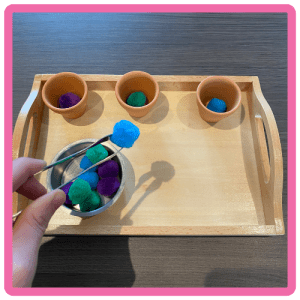In Montessori education, transferring and sorting activities are essential for a child’s development of fine motor skills, hand-eye coordination, concentration, and cognitive skills.
Transferring: Transferring refers to the action of moving objects from one container to another using tools such as tongs, spoons, tweezers, or simply the child’s fingers. The aim is to develop precise hand movements, dexterity, and coordination. The child learns to control the tools and objects, refining their grip, and developing the small muscles in their hands.
Sorting: Sorting involves the classification or organisation of objects based on specific attributes. Children learn to group items by similarities and differences, like sorting items by colour, shape, size, or any other distinguishing feature. This activity fosters cognitive skills, visual discrimination, and logical thinking as children learn to recognise patterns and categorise items.

1. Introduce the Activity:
2. Demonstrate the Activity:
3. Offer Verbal Instructions:
4. Encourage Independent Practice:
5. Introduce Challenges:
6. Maintain the Environment:
7. Rotate Materials:
8. Observe and Assess:
9. Encourage Creativity:
10. Closure and Clean-Up:
These activities help in refining and strengthening the small muscles in a child’s hands, known as fine motor skills. Using tools like tongs, spoons, or their fingers to transfer and sort small objects enhances their hand-eye coordination, dexterity, and precision. This development is crucial for later skills such as writing, drawing, and self-care tasks like buttoning clothes.
Transferring and Sorting activities encourage cognitive growth in children. By categorising and organising objects based on different attributes like colour, shape, size, or texture, children engage in critical thinking, problem-solving, and classification skills. They learn to recognize patterns, similarities, and differences, laying the foundation for logical thought and systematic understanding.
Engaging in these activities requires a high level of concentration and attention to detail. Children learn to focus on the task at hand, improving their ability to concentrate for more extended periods. As they become absorbed in the activity, they develop patience and perseverance, fostering a sense of inner discipline and self-control.
Thank you for reading the latest edition of Material Spotlight: Transferring and Sorting.
Tell us in the form below, what Montessori Material Spotlight we should cover next!